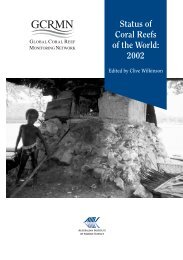Sustainable Livelihoods Enhancement and Diversification (SLED)
Sustainable Livelihoods Enhancement and Diversification (SLED)
Sustainable Livelihoods Enhancement and Diversification (SLED)
Create successful ePaper yourself
Turn your PDF publications into a flip-book with our unique Google optimized e-Paper software.
1.3.3 Implementing strategies to build consensus for change<br />
In response to the consensus-building strategy the teams should initiate a series of activities that can assist<br />
the community in developing an underst<strong>and</strong>ing about their relationships with coastal ecosystems <strong>and</strong><br />
forming a consensus that change is required. Examples of such initiatives include:<br />
• Children <strong>and</strong> youth clubs – provide a key group of stakeholders with activities to build their connection<br />
with the environment<br />
• Household monitoring it books – provided to households to record the changes that they experience<br />
<strong>and</strong> the impacts on their livelihoods<br />
• Awareness raising – engaging groups in activities designed to develop underst<strong>and</strong>ing <strong>and</strong> discussion<br />
about coastal <strong>and</strong> marine ecosystems<br />
• Engaging community members in coastal <strong>and</strong> marine ecosystems monitoring – engaging stakeholders<br />
in basic monitoring tasks can help them to identify changes as they are happening with these<br />
ecosystems<br />
1.4 Building visions for livelihood development<br />
Helping people to think about the situation in<br />
which they would like to be in the future should be<br />
the starting point of any process for livelihood<br />
development. Through developing, presenting <strong>and</strong><br />
celebrating people’s visions we are giving voice to<br />
their aspirations <strong>and</strong> hopes. People’s visions for<br />
their livelihoods in the future will reflect not just<br />
their own personal aspirations for income<br />
enhancement or diversification, but also their<br />
wider livelihood priorities. This requires facilitation<br />
to encourage people to develop visions that are<br />
challenging, <strong>and</strong> based on people’s strengths <strong>and</strong><br />
past successes rather than their problems <strong>and</strong><br />
weaknesses, both for people <strong>and</strong> for the<br />
community as a whole.<br />
Perceptions of <strong>SLED</strong> from the field:<br />
Appreciating strengths through visioning<br />
Within the community the visioning process has<br />
brought people together around their common<br />
visions. People belonging to different groups <strong>and</strong><br />
even the poorest of the poor participated in the<br />
process with total involvement, sharing their vision,<br />
strengths they have <strong>and</strong> the support they require to<br />
make the vision a reality. It brings lot of energy into<br />
the people as many were feeling happy to share their<br />
visions in such a manner.<br />
PAD, <strong>SLED</strong> field level implementer, Gulf of Mannar,<br />
India<br />
Photo: Puttalam lagoon, Sri Lanka (© J Tamel<strong>and</strong>er/IUCN).<br />
33
















